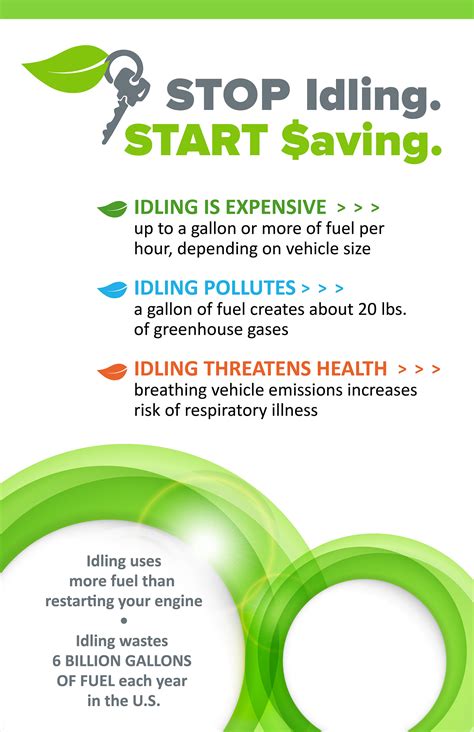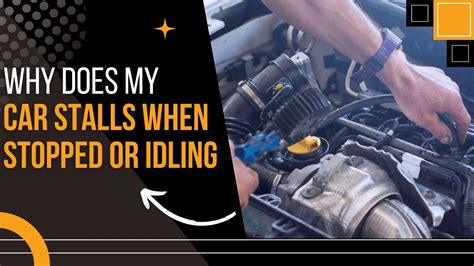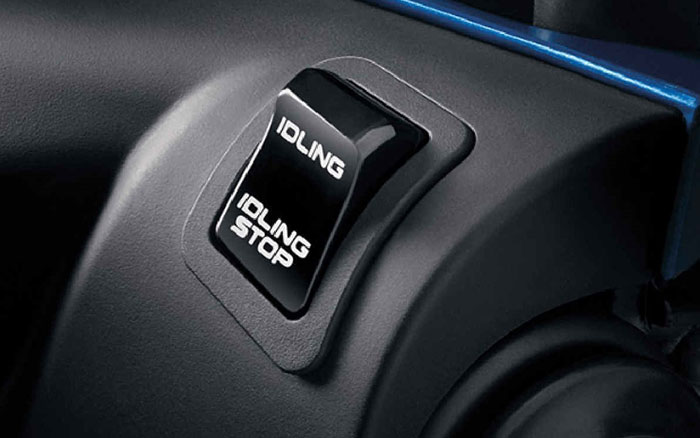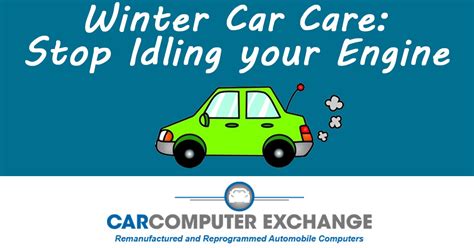Stop Idling

The world is shifting towards a more sustainable and environmentally conscious future, and one key aspect of this transition is the reduction of idling vehicles. Idle reduction is a simple yet effective strategy to conserve fuel, reduce greenhouse gas emissions, and minimize the environmental impact of transportation. This comprehensive article will delve into the importance of idle reduction, its benefits, and the strategies to implement it effectively.
Understanding the Impact of Idling

Idling refers to the practice of keeping a vehicle’s engine running while stationary. It might seem like a harmless habit, but the cumulative effect of idling vehicles has a significant environmental and economic impact. Here’s a closer look at the issues idling vehicles present.
Environmental Consequences
Idle vehicles contribute to air pollution and the emission of greenhouse gases. According to the Environmental Protection Agency (EPA), idling vehicles emit harmful pollutants such as nitrogen oxides, carbon monoxide, and particulate matter. These pollutants are associated with various health issues, including respiratory problems and cardiovascular diseases.
Additionally, idling contributes to global warming. The EPA estimates that idling vehicles in the United States emit over 17 million tons of carbon dioxide annually, equivalent to the annual greenhouse gas emissions of over 3.8 million cars.
| Pollutant | Health Effects |
|---|---|
| Nitrogen Oxides (NOx) | Respiratory issues, smog formation |
| Carbon Monoxide (CO) | Reduced oxygen delivery, dizziness, headaches |
| Particulate Matter (PM) | Lung damage, cardiovascular disease |

Fuel Consumption and Costs
Idling wastes fuel and money. The EPA estimates that idling a typical light-duty vehicle (like a car or small truck) for just 5 minutes a day can consume over 1 gallon of fuel annually. This may seem insignificant, but when multiplied across millions of vehicles, the fuel waste is substantial.
For example, a fleet of 1000 vehicles idling for 10 minutes daily would waste approximately 20,000 gallons of fuel annually. This equates to a significant financial loss for businesses and individuals alike.
Benefits of Idle Reduction

Implementing idle reduction strategies offers a multitude of benefits, both for the environment and for businesses and individuals. Here’s an in-depth look at these advantages.
Environmental Benefits
Reducing idling is a simple yet effective way to decrease air pollution and greenhouse gas emissions. By minimizing idling, we can improve air quality, especially in urban areas where vehicle emissions are a significant concern. This leads to a healthier environment and reduced health risks associated with air pollution.
Idle reduction also contributes to mitigating climate change. By reducing the emission of carbon dioxide and other greenhouse gases, we can slow down the rate of global warming and its associated impacts, such as extreme weather events and rising sea levels.
Economic Benefits
For businesses, idle reduction can lead to substantial cost savings. As mentioned earlier, idling wastes fuel, and by extension, money. By implementing idle reduction strategies, businesses can reduce their fuel costs, leading to increased profitability.
For example, a trucking company that implements an idle reduction policy could see significant fuel savings. A truck idling for 8 hours a day could consume up to 1 gallon of fuel per hour, resulting in a daily fuel waste of 8 gallons. Over a year, this could amount to thousands of dollars in savings.
Improved Engine Efficiency
Idling is not only a waste of fuel but can also be detrimental to engine efficiency and performance. Prolonged idling can lead to carbon buildup in the engine, which can reduce efficiency and increase fuel consumption. By reducing idling, engines can operate more efficiently, leading to better performance and longer engine life.
Strategies for Idle Reduction
Idle reduction is not a one-size-fits-all solution. Different strategies can be employed depending on the type of vehicle, the duration of idling, and the context in which idling occurs. Here are some effective strategies to reduce idling.
Vehicle Technologies
Advancements in vehicle technology have led to the development of idle reduction technologies. These technologies aim to reduce idling by automatically shutting off the engine when the vehicle is stationary for a certain period and restarting it when the driver needs to move again.
One example is the automatic engine stop-start system, which is now a standard feature in many new vehicles. This system turns off the engine when the vehicle comes to a stop, such as at a red light or in traffic, and restarts it when the driver releases the brake pedal.
Other technologies include auxiliary power units (APUs) and idle reduction units (IRUs), which are particularly useful for long-haul trucks. These systems provide electrical power and heating/cooling while the engine is off, eliminating the need for idling.
Driver Education and Training
Education and training play a crucial role in idle reduction. Many drivers are unaware of the environmental and economic impacts of idling or simply don’t realize how much time they spend idling. By educating drivers about the benefits of idle reduction and providing them with tips and strategies to reduce idling, we can encourage a behavioral shift.
For example, drivers can be trained to turn off their engines when waiting for more than 10 seconds, especially in situations like drive-thrus or while loading/unloading goods. Simple reminders and signs can also be effective in encouraging drivers to switch off their engines.
Policy and Regulation
Policy and regulation can play a significant role in encouraging idle reduction. Governments and municipalities can implement regulations that limit the amount of time vehicles can idle. For instance, some cities have enacted anti-idling laws that prohibit idling for more than 3 minutes, with penalties for non-compliance.
Policies can also incentivize the adoption of idle reduction technologies. For example, governments can offer tax incentives or rebates for businesses and individuals who install idle reduction technologies in their vehicles.
Alternative Power Sources
In certain situations, idling is necessary to power auxiliary equipment or provide heating/cooling. In such cases, alternative power sources can be utilized to reduce idling. For instance, shore power can be used at ports and terminals to provide electrical power to ships, eliminating the need for idling while docked.
Similarly, solar-powered charging stations can be used to provide power for vehicles while they are parked. This is particularly useful for electric vehicles, as it allows them to recharge without idling their engines.
Case Studies: Idle Reduction in Action
Idle reduction strategies have been successfully implemented in various sectors, leading to significant environmental and economic benefits. Here are a few case studies highlighting the effectiveness of idle reduction.
The Idle-Free School Zone Initiative
The Idle-Free School Zone Initiative was implemented in several US states to reduce idling around schools. This initiative educated parents and caregivers about the impacts of idling and encouraged them to turn off their engines while waiting to pick up or drop off their children. As a result, idling was reduced by up to 70% in some school zones, leading to improved air quality and reduced greenhouse gas emissions.
Idle Reduction in the Trucking Industry
The Trucking Industry has been a major adopter of idle reduction strategies. Many trucking companies have implemented policies and technologies to reduce idling, leading to significant fuel savings. For example, a major trucking company reported a fuel savings of over $3 million annually after implementing idle reduction strategies across its fleet.
Idle Reduction in the Marine Sector
The Marine Sector has also made significant strides in idle reduction. The use of shore power has become increasingly common, especially in environmentally sensitive areas. For instance, the Port of Los Angeles has implemented a shore power program, allowing ships to turn off their engines and connect to the electrical grid while docked, reducing air pollution and greenhouse gas emissions.
Future Prospects and Innovations

As we move towards a more sustainable future, the importance of idle reduction will only increase. Here are some future prospects and innovations that could further enhance idle reduction efforts.
Advanced Vehicle Technologies
Advancements in vehicle technology will continue to drive the development of more efficient idle reduction technologies. For instance, the integration of hybrid systems and electric powertrains will allow vehicles to operate with zero emissions while stationary, eliminating the need for idling.
Additionally, the use of solar panels on vehicles could provide a renewable power source, further reducing the need for idling.
Smart Infrastructure
The development of smart infrastructure could play a significant role in idle reduction. For example, smart traffic lights could communicate with vehicles, providing real-time information about traffic flow and reducing the need for idling at intersections.
Similarly, smart parking systems could guide drivers to available parking spots, reducing the time spent idling while searching for parking.
Policy and Behavioral Changes
Policy changes and behavioral shifts will be crucial in reducing idling on a larger scale. Governments and municipalities can continue to implement and enforce anti-idling regulations, while also incentivizing the adoption of idle reduction technologies.
Additionally, public awareness campaigns and education initiatives can encourage individuals to make conscious choices to reduce idling, leading to a collective effort towards a more sustainable future.
How much fuel is wasted by idling vehicles annually in the US?
+According to the EPA, idling vehicles in the US waste over 6 billion gallons of fuel annually, equivalent to over $22 billion in fuel costs.
What are the health risks associated with idling vehicle emissions?
+Idling vehicles emit harmful pollutants like nitrogen oxides, carbon monoxide, and particulate matter. These pollutants are associated with respiratory issues, cardiovascular diseases, and other health problems.
How can businesses benefit from idle reduction strategies?
+Businesses can benefit from idle reduction by reducing their fuel costs, leading to increased profitability. Idle reduction also improves engine efficiency and reduces maintenance costs.
What are some effective strategies for idle reduction in the trucking industry?
+Trucking companies can implement idle reduction strategies such as auxiliary power units (APUs) and idle reduction units (IRUs) to provide power and heating/cooling while the engine is off. Driver training and policy changes can also encourage idle reduction.
What is the potential of smart infrastructure in idle reduction?
+Smart infrastructure, such as smart traffic lights and parking systems, can provide real-time information and guidance, reducing the time vehicles spend idling. This has the potential to significantly reduce idling in urban areas.


